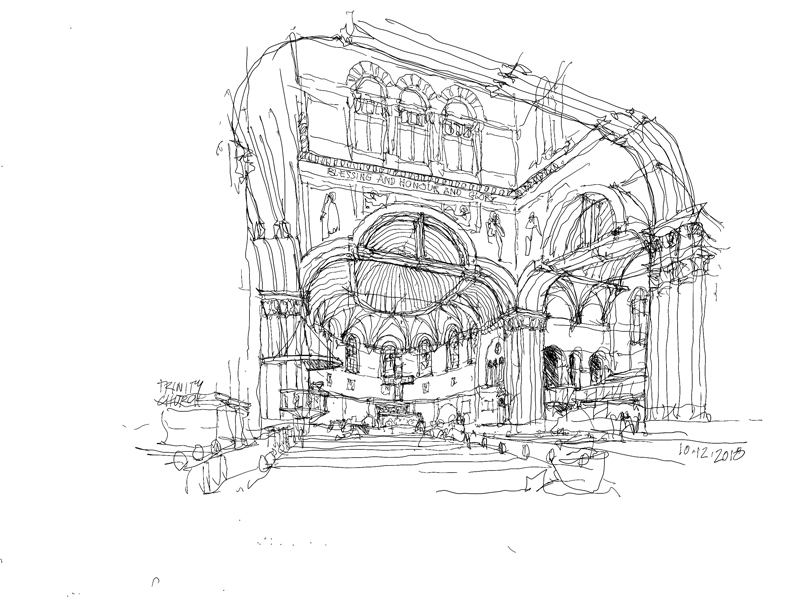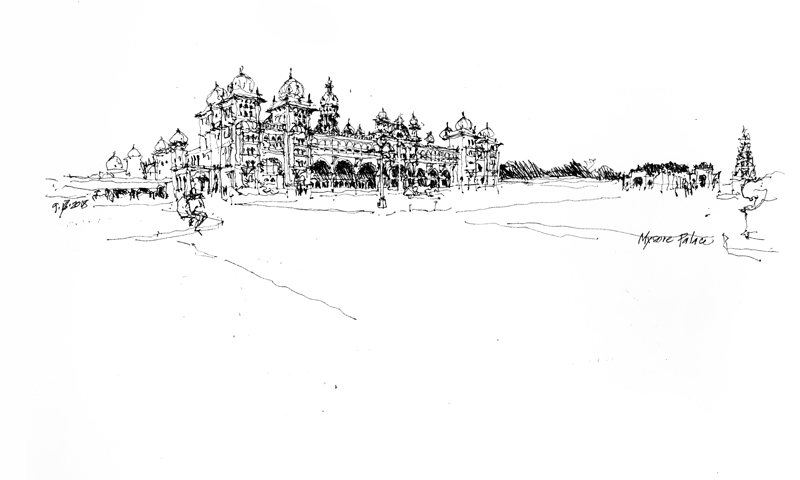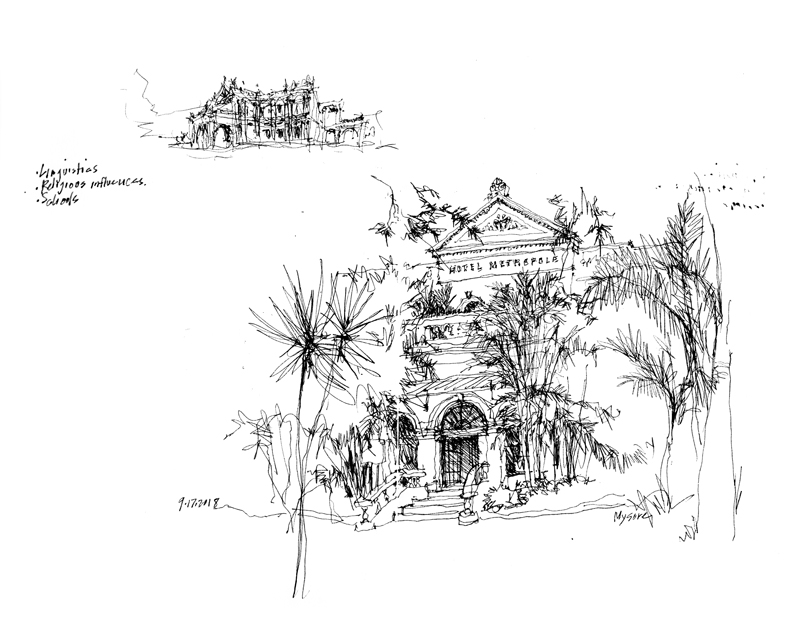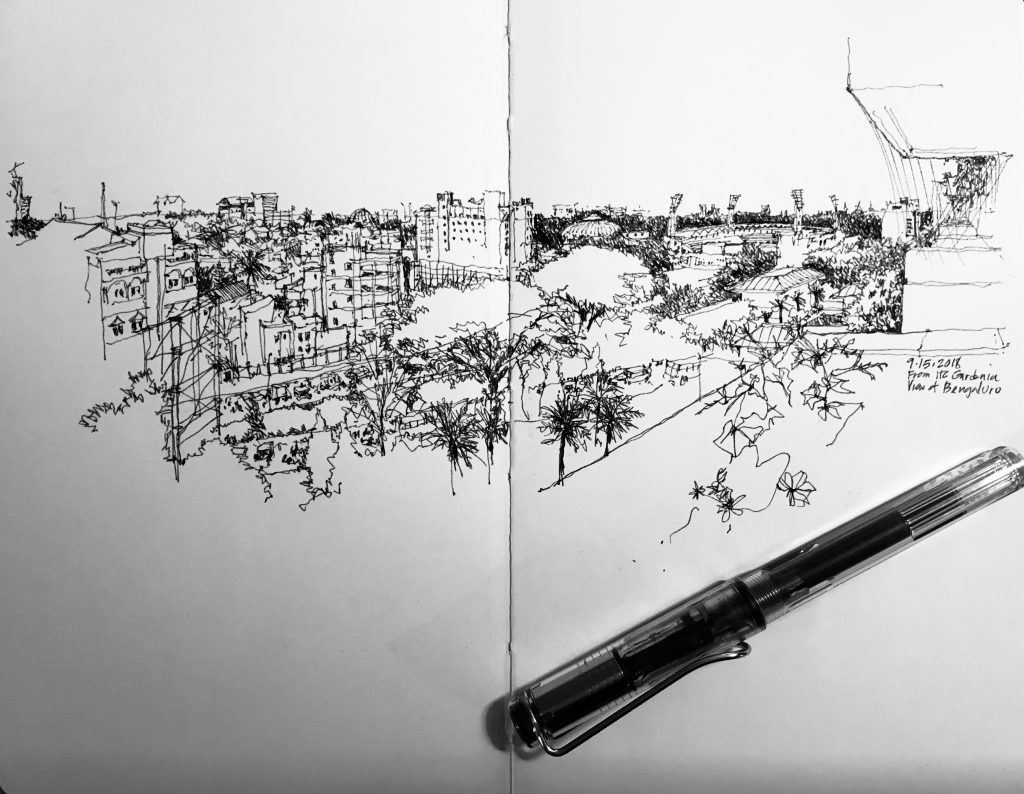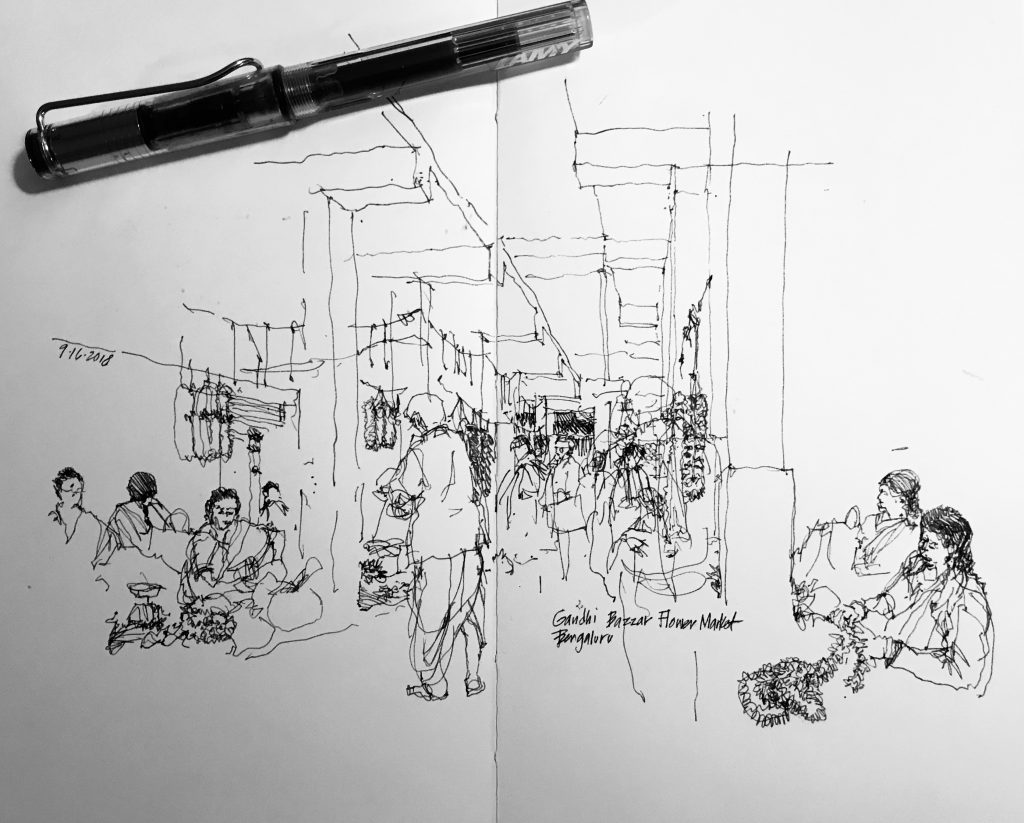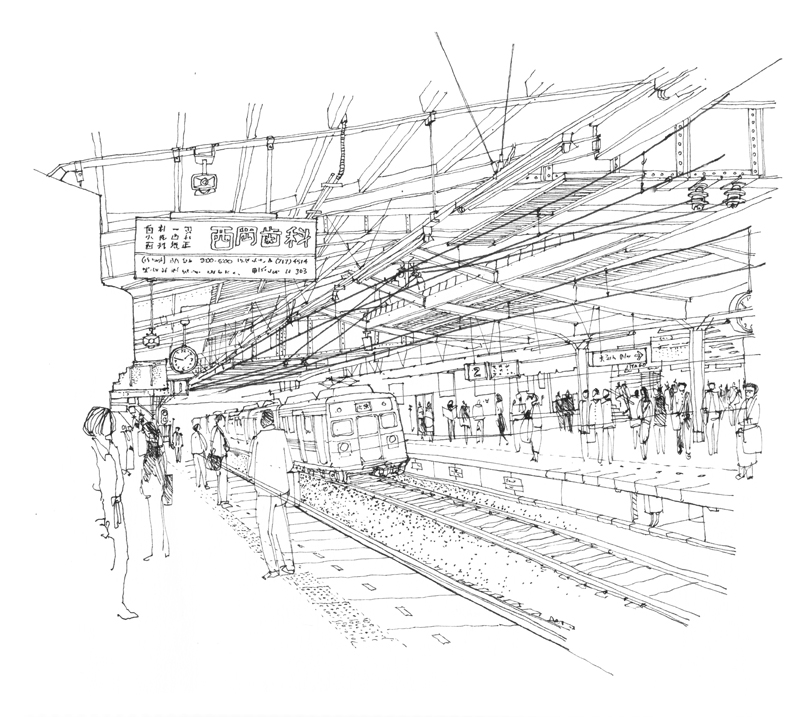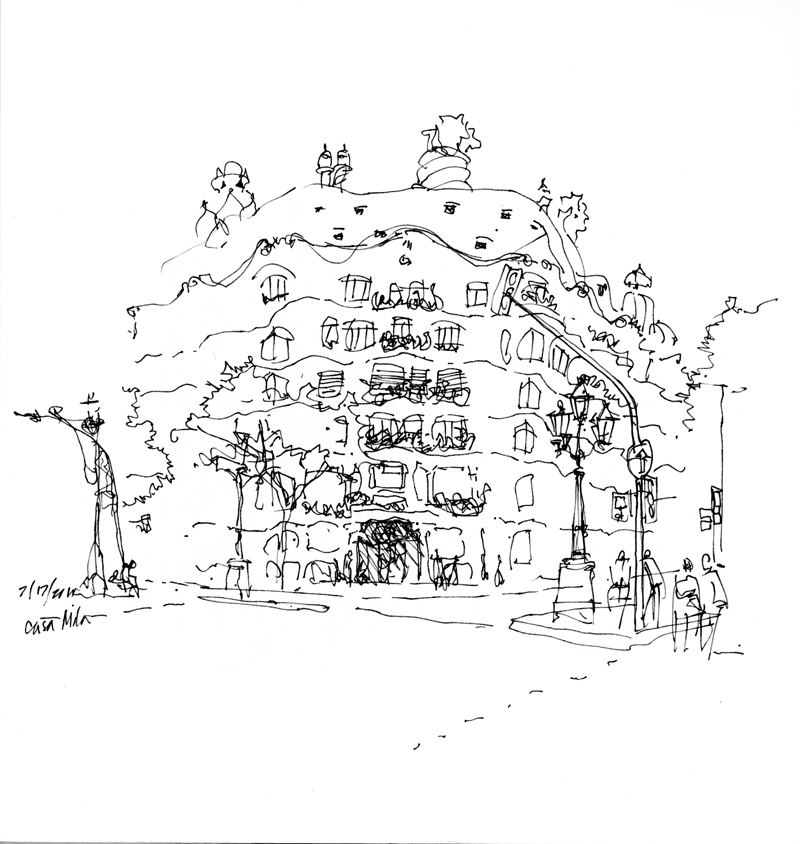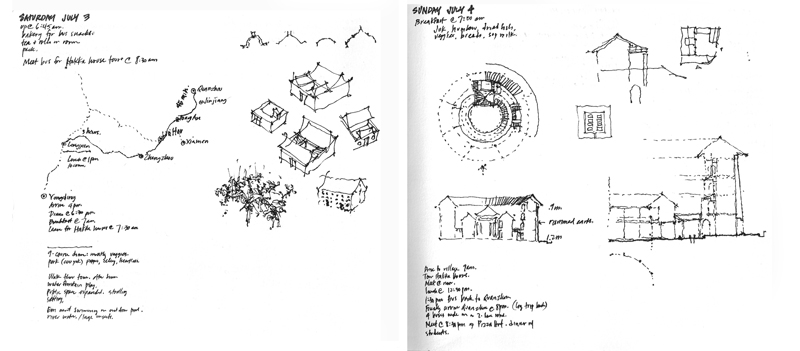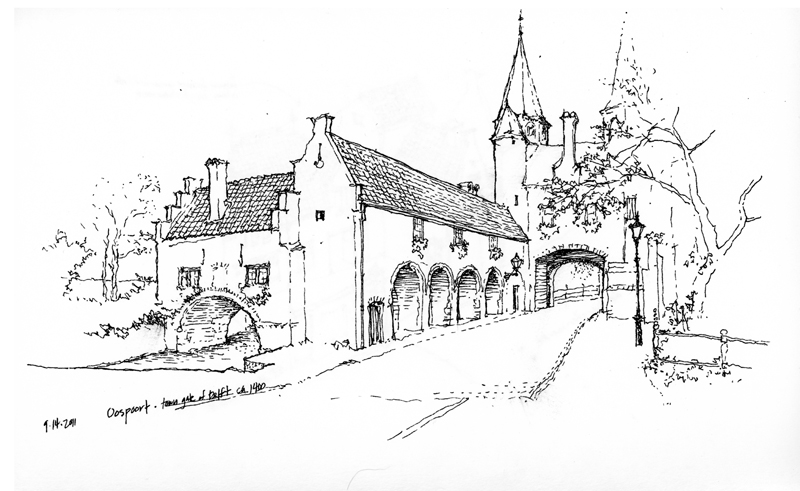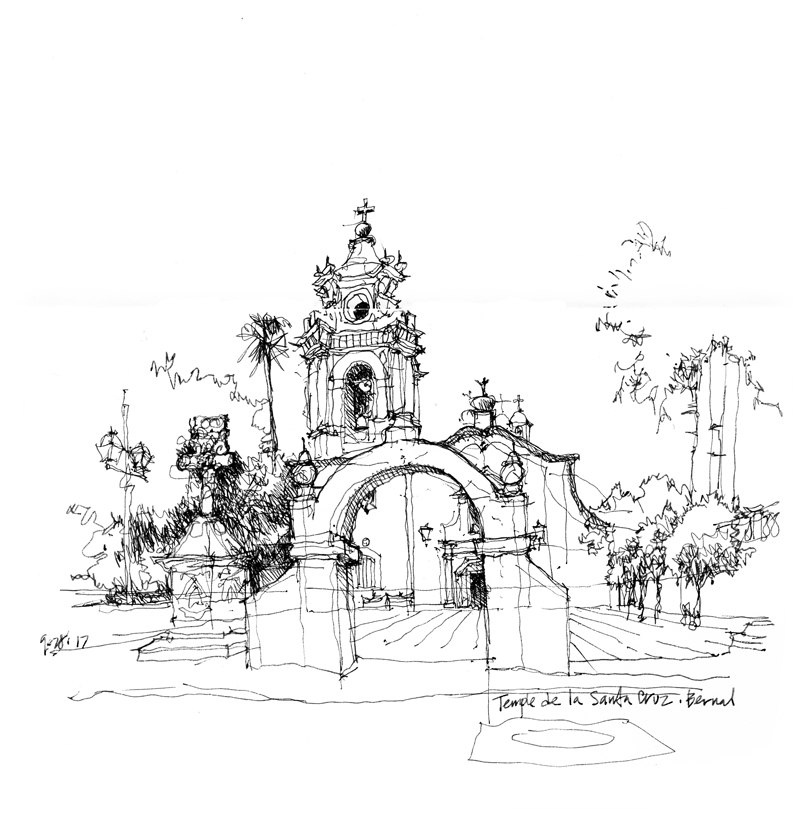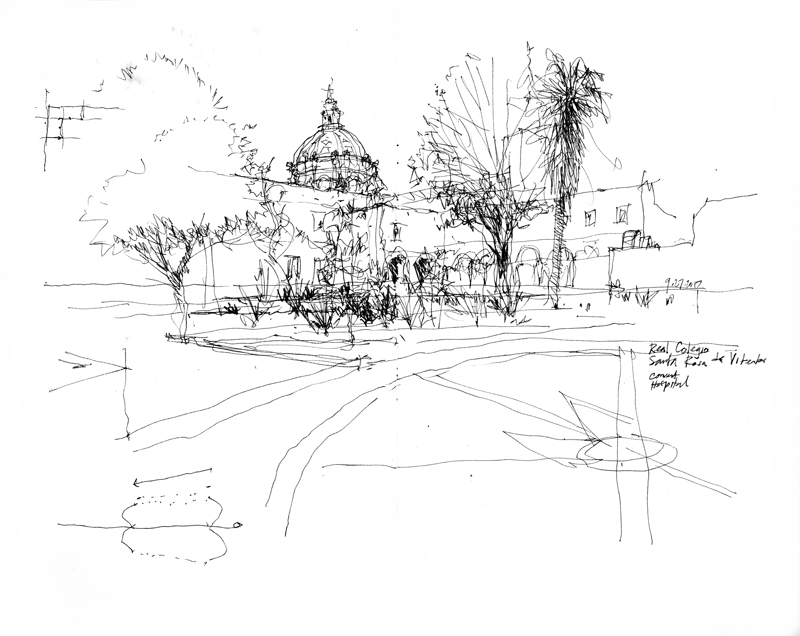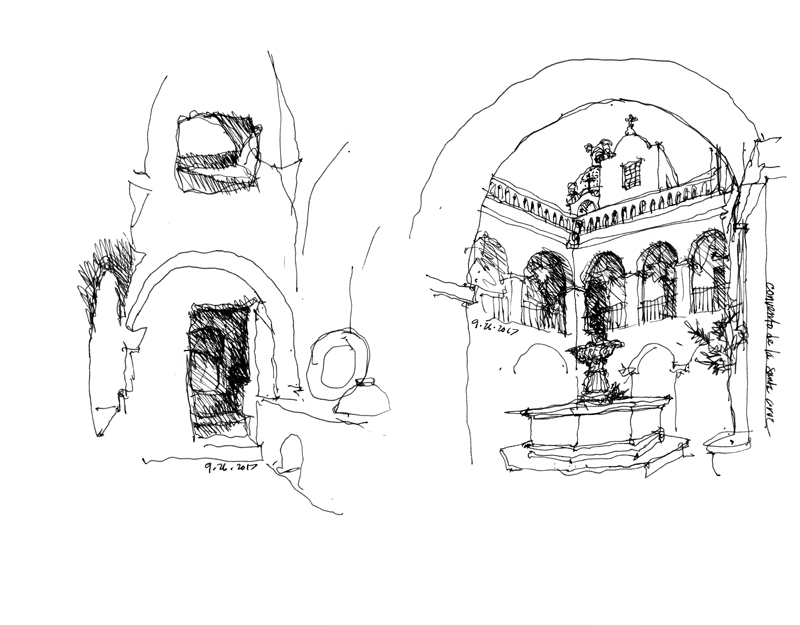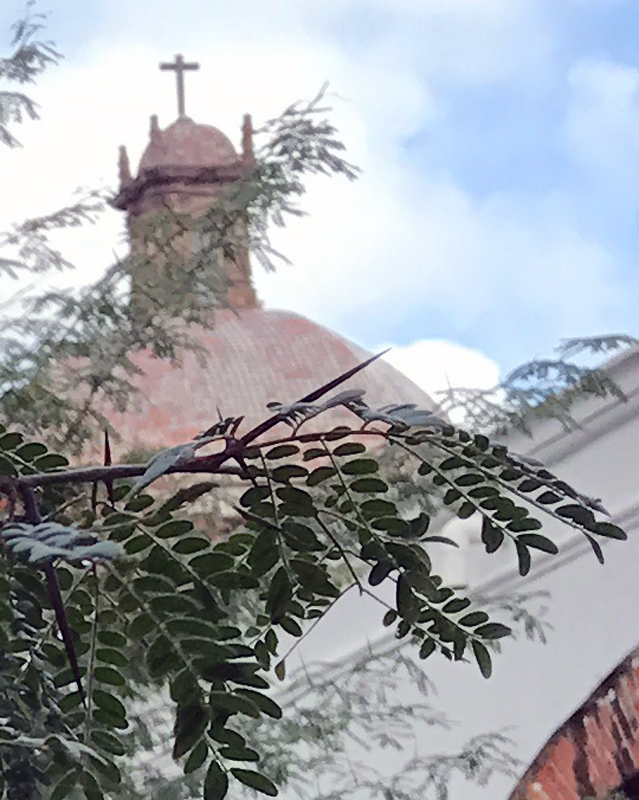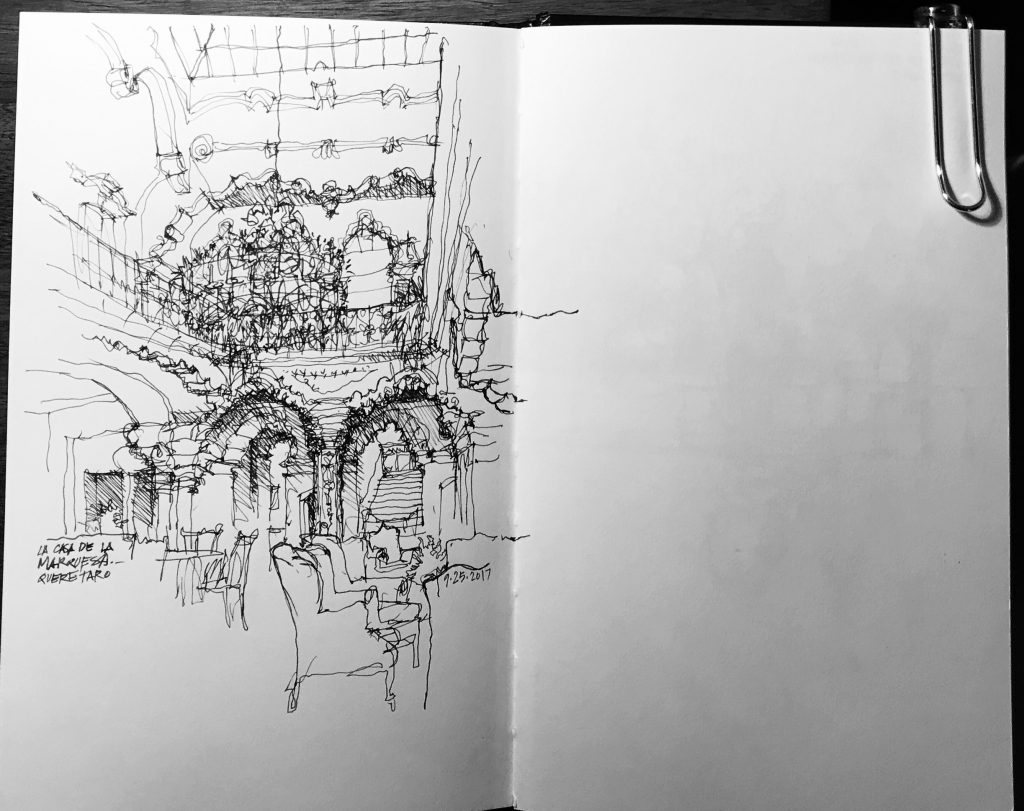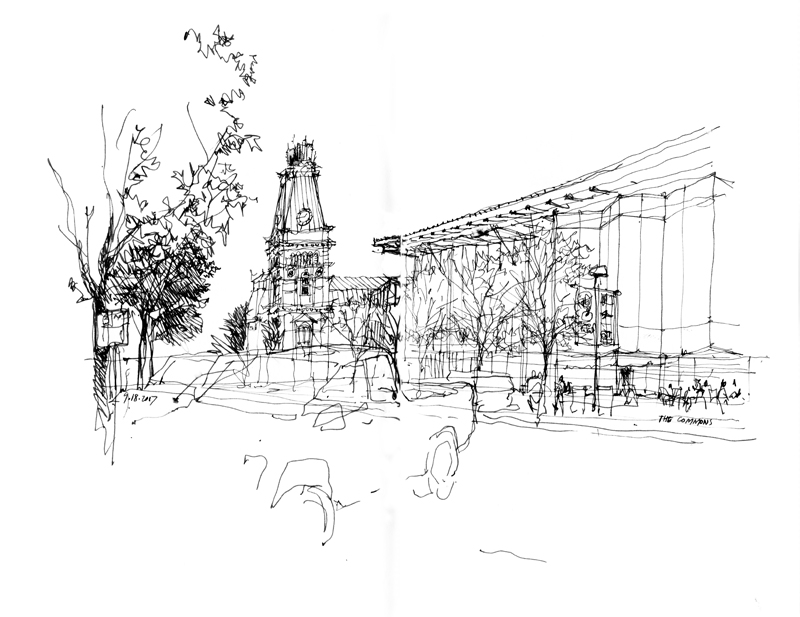Here is a view of the interior of Trinity Church in Boston, showing how the sanctuary occupies one arm of the Greek-cross plan while the congregation occupies the airy crossing and the other three arms. Here is a video clip of the drawing process.
Category Archives: Travel
Mysore
From Bengaluru, we drove to Mysore, where I met with faculty and students at the Wadiyar Centre for Architecture and toured Mysore Palace. The above is a 25-minute sketch of Mysore Palace I managed to do before leaving on the 5-hour drive to Calicut.
The residence of the Wadiyar Dynasty, the first palace dates from the 14th century and was built within the confines of the puragiri or citadel of Mysore. Over the centuries, the palace was rebuilt several times. The existing Indo-Saracenic structure, designed by the British architect Lord Henry Irwin, was constructed between 1897 and 1912, after the previous structure was extensively damaged during a fire in 1896.
Below is the entrance to the Royal Orchid Metropole where I had spent the night. This was originally built to serve as a residence for British guests of the Maharaja of Mysore.
Bengaluru
Many thanks to Anand Krishnamurthy and his colleagues of MASA (Alumni Association of the Malnad Architecture School) for giving me the opportunity to visit Bengaluru and address an audience of architects and students. Also had the opportunity to tour the city, visiting temples and markets. Above is a view of the city from my hotel balcony and below is a sketch of the flower market, where the activity became more important than the architecture.
More Changes, But For Other Reasons
Plaza de Armas
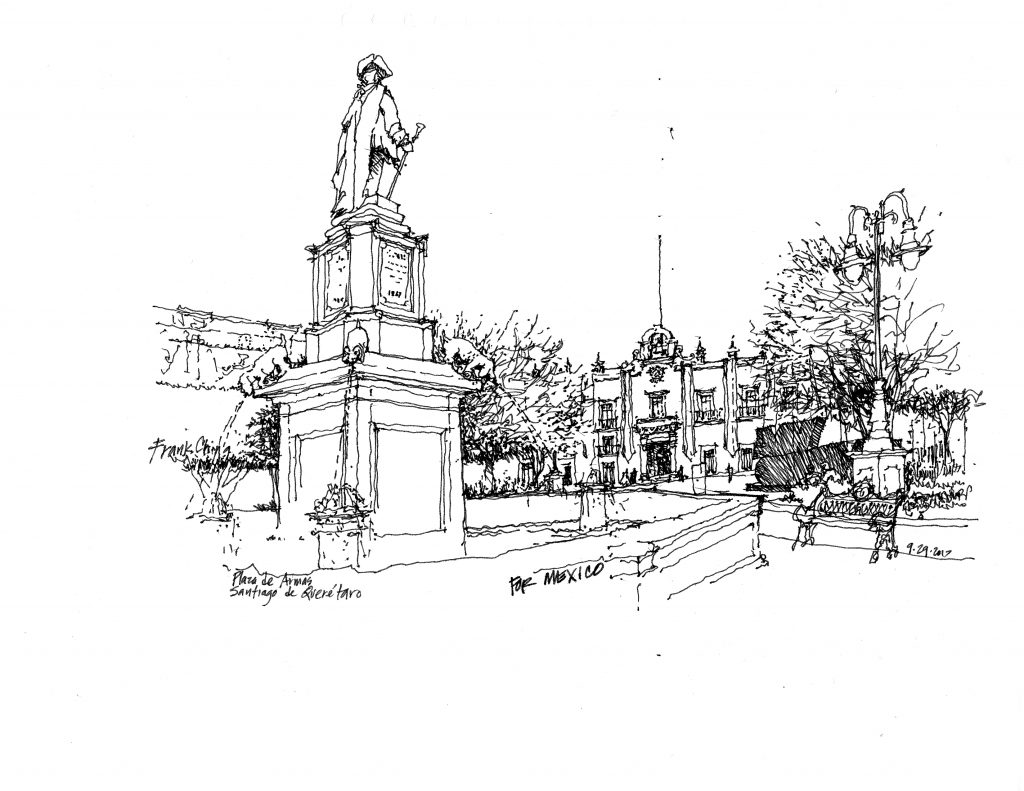 Here is a view of Plaza de Armas, also known as the Plaza de Independencia, in Querétaro. In the foreground is a fountain with a statue of Juan Antonio de Urrutia y Arana, who was responsible for the construction of a 4200-foot long aqueduct to bring water to the city from La Cañada in the early 18th century. He is looking toward the Palacio de la Corregidora, residence of Don Miguel Domínguez and his wife Josefa Ortiz de Domínguez, who is revered for her role in liberating Mexico from Spain. The palace is now the seat of the state government of Querétaro.
Here is a view of Plaza de Armas, also known as the Plaza de Independencia, in Querétaro. In the foreground is a fountain with a statue of Juan Antonio de Urrutia y Arana, who was responsible for the construction of a 4200-foot long aqueduct to bring water to the city from La Cañada in the early 18th century. He is looking toward the Palacio de la Corregidora, residence of Don Miguel Domínguez and his wife Josefa Ortiz de Domínguez, who is revered for her role in liberating Mexico from Spain. The palace is now the seat of the state government of Querétaro.
Along the west side of the plaza is this view corridor, with a carefully pruned mass of Indian laurel trees on the left and on the right, the Casa de Ecala, an 18th-century baroque mansion named after Tomás López de Ecala. The casa is now home of DIF (Desarrollo Integral de La Familia), a state agency offering social assistance to Mexican families.
Santa Rosa de Viterbo
 The public enters the 1752 Church of Santa Rosa de Viterbo through twin entrances on the north side rather than the more typical west end, which abuts a busy street. This view is drawn from the Plaza Mariano de las Casas, created in 1964 to increase the visibility of this north side of the church.
The public enters the 1752 Church of Santa Rosa de Viterbo through twin entrances on the north side rather than the more typical west end, which abuts a busy street. This view is drawn from the Plaza Mariano de las Casas, created in 1964 to increase the visibility of this north side of the church.
Santa Rosa de Viterbo was originally associated with a convent whose nuns devoted themselves to primary education. After the convent was closed in 1861 due to the Reform Laws, the facility was transformed into a hospital. Today, the convent portion is the Centro de Estudios de Diseño y Artes Graficas Mexico-Italiano.
Scenes from Querétaro
We often are enthralled with monuments and monumental buildings and do not pay enough attention to the uniqueness and beauty of the more mundane places we encounter. Here are a couple of views of the commonplace. The first is the short pedestrian-only Calle V. Carranza, in the historic center of Querétaro. At the east end of the narrow street stands a bust of Venustiano Carranza Garza (1859–1920), the first elected president of the newly formed Mexican Republic in 1917, after the Mexican Revolution of 1910, and under whose watch the 1917 Constitution was ratified.
The second view illustrates the power of a simple line drawing to capture a scene—this one a table at Maria y su Bici, a Oaxacan mezcaleria in Querétaro.
Church and Monastery of Santa Cruz
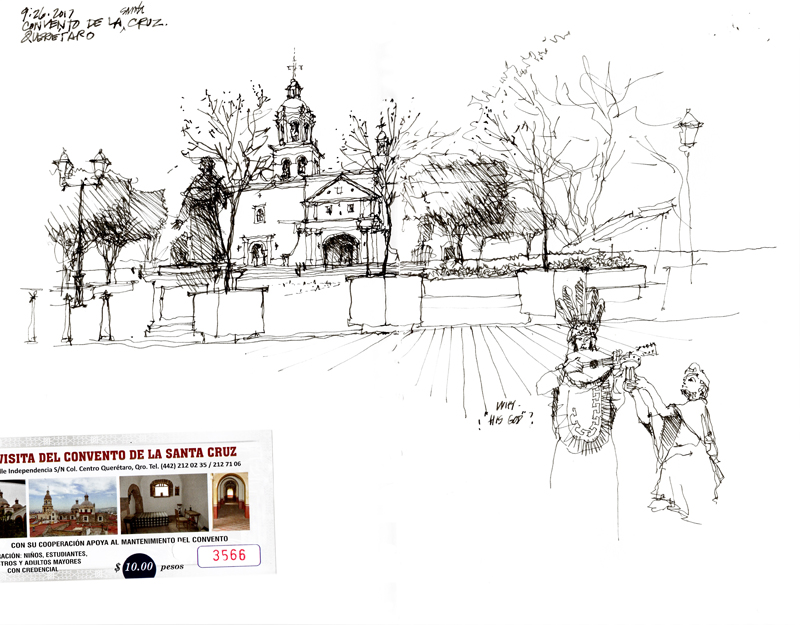 The Franciscan Church and Monastery of Santa Cruz (Iglesia y Convento de la Santa Cruz) dates from the 16th century and is named for the pink stone cross on the main altar. This cross commemorates the appearance of St. James that was supposed to have occurred on July 25, 1531 as the Spanish and their Nahuan allies battled the Otomi and Chichimecas on the hill where the church and monastery are now located. The well preserved compound consists of a series of cloisters and monk’s cells, along with a kitchen, orchard, water reservoir, and related ancillary facilities.
The Franciscan Church and Monastery of Santa Cruz (Iglesia y Convento de la Santa Cruz) dates from the 16th century and is named for the pink stone cross on the main altar. This cross commemorates the appearance of St. James that was supposed to have occurred on July 25, 1531 as the Spanish and their Nahuan allies battled the Otomi and Chichimecas on the hill where the church and monastery are now located. The well preserved compound consists of a series of cloisters and monk’s cells, along with a kitchen, orchard, water reservoir, and related ancillary facilities.
The first missionary school in the Americas, the School for the Propagation of the Faith (Colegio de la Propagación de la Fe) was established here. From this school, Franciscan friars ventured forth to establish missions as far north as what is now Texas and California.
In one of the courtyards is a thorn tree which, according to legend, grew from the walking stick that the missionary Fray Antonio Margil de Jesús stuck in the ground during his stay at the monastery. What is notable is that the tree bears thorns having three spines in the shape of a cross.
Santiago de Querétaro
I’ve spent a week in Santiago de Querétaro, a UNESCO World Heritage Site, exploring the historic center and drawing with a wonderful group of students from the School of Architecture, Art and Design at Tecnologico de Monterrey. At the end of the first day’s activities, as I was walking back to my hotel, this casa was pointed out to me. It was built in 1756 for the Marquesa de Villar and is now a boutique hotel. Seeing the richness of the entry court, I felt compelled to draw to stop and draw it. More drawings to come.
Columbus, Indiana
Earlier this week, I spent three days in Indianapolis to participate in a video project for my publisher Wiley. On the first day, we drove down to Columbus, Indiana, for some on-location sketching. Here are a couple of quick sketches that I did as studies before I attempted the larger format drawings that were to be filmed.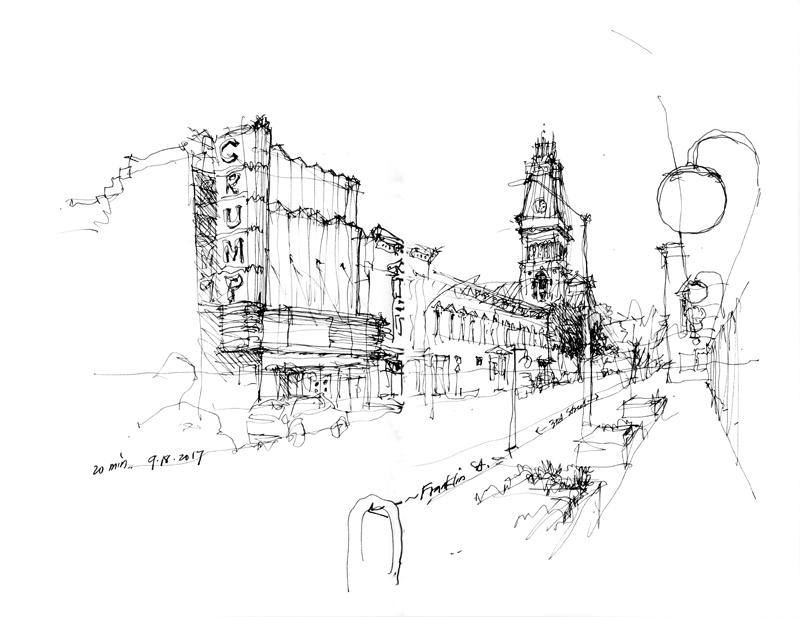
Columbus is known for its collection of Modernist projects that are interspersed among the town’s older 19th-century buildings. This unusual architectural heritage owes its existence to J. Irwin Miller who, as president and chairman of Cummins Engine Company, created the Cummins Foundation in the mid-1950s to subsidize projects by Eero Saarinen, I.M. Pei, S.O.M., Cesar Pelli, Richard Meier, and Robert Venturi, among others.
Thanks to Lauren, LIsa, Paul, and Eric for their expert assistance in making this project possible, and to the Ball State University students who participated in the studio sessions.

